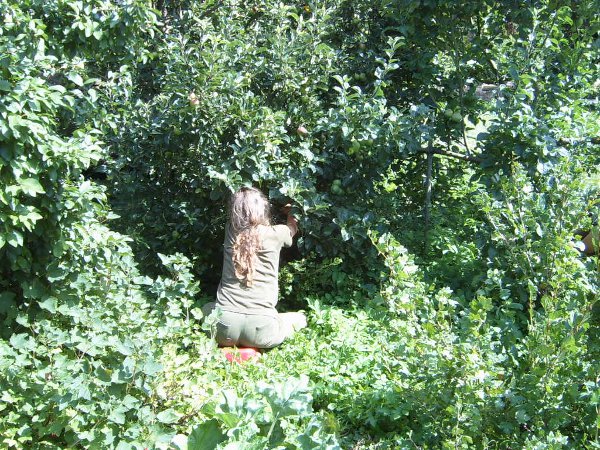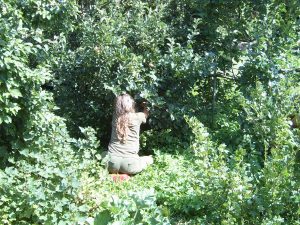“It is the cumulative yield of all the plants living on the same piece of land that makes forest gardens productive, not the high yield of individuals.” ―
Contents
What is forest gardening?
It’s gardening in a way intended to mimic a natural forest ecosystem, except that the species chosen are mainly edible. Some will be chosen for other reasons too – for example firewood, nitrogen fixing, flowers or medicines.
“Imagine a garden that needs no weeding, watering, digging or feeding and can be left to look after itself for weeks, even months, on end.” – excerpt from Jill Tunstall’s article the Garden of the Future? from the Guardian.

Three layers of perennial plants – the herb layer is valerian (medicinal), the shrub layer is flax (fibres), and the canopy is fruit and firewood trees.
So a forest garden is a sustainable garden using diverse, perennial edible species, based upon the structure of native woodland, which means that there are layers – from the tops of trees down to the ground, and to the roots underneath it. Seven layers are generally identified:
- canopy trees – standard large trees
- smaller shade-tolerant trees, from dwarf stock, for fruit and nuts
- shrubs and bushes such as currants and berries
- herbaceous layer of perennial herbs and vegetables
- groundcover plants
- underground layer – root crops
- vertical layer of climbers – vines, beans etc, trained to climb up the trees and bushes
Great introductory video from Permaculture People.
Forest gardening is an ancient practice; there’s evidence that people (and animals) have consciously shaped the forests in which they lived for millennia. In tropical Asia, China and Africa, complex forest gardens have existed for thousands of years. In the UK most of the temperate forest was lost a long time ago – cleared for monocultures of grain crops, grazing or felled for building ships and housing.
Forest gardening pioneer Robert Hart visited tropical forest gardens, studied ecology, and then used his knowledge to create the first temperate forest garden in Shropshire in the 1970s. He also wrote the first books on the subject. His work has been the inspiration for the UK forest gardening movement and many people have built upon his work, refining and adding to the theory and practice.

The seven layers of a forest garden. Image: Graham Burnett, CC BY-SA 3.0
There are now hundreds of forest gardens (often also called ‘home gardens’) in the UK. Most of these are less than 20 years old and small scale (0.25-2.5 acres).
Here are some examples of the kinds of produce you can expect to harvest from a forest garden:
Trees: apple, pear, cherry plum, quince, mulberry, medlar, peach, chestnut, pine nut, almond, hazelnut, juneberry, strawberry tree, pawpaw, blue bean, persimmon, bladdernut, snowbell tree.
Shrubs: currant, Chilean guava, plum, blueberry, wineberry, Oregon grape, almonberry, whortleberry.
Perennial vegetables: bamboo (shoots), sea kale, perpetual spinach, perennial broccoli, wild garlic, Babbington leek, good King Henry, fat hen, everlasting onion.
Geoff Lawton explains how to maximise output and minimise input with a ‘food forest’.
Roots: pignut, Jerusalem artichoke, horseradish, earthnut pea, wasabi.
Herbs: whole range of herbs for cooking and medicinal use.
Climbers: grape, loganberry, tayberry, strawberry grape, kiwi fruit, hop.
Fungi: oyster, shiitake, lion’s mane.
Cut and come again salad: sorrel, wild rocket, lambs lettuce, mustard, wrinkled cress.
Plus: fuel wood from coppice, basketry materials, dye plants, garden canes and ties.

This is a good example of a guild – a group of plants that are mutually beneficial; here comfrey provides ground cover and is a mineral accumulator (can be cut to produce a mineral-rich mulch for fruit trees), aromatic herbs protect fruit from pests, currant bushes are planted around the drip line of the trees so that they get watered, plus redcurrants do well in the shade of the apple tree.
What are the benefits of forest gardening?
At present most of our food needs are met by giant agri-businesses who use monoculture systems to produce fruit and vegetable crops. These systems are heavily dependent on oil, pesticides and synthetic fertilisers, and are slowly eroding and polluting our soils and watercourses. Forest gardening presents a different approach to food production, that:
- is resilient, withstanding drought and flooding through well-developed root and mycorrhizal networks;
- maintains soil fertility and can be used to reclaim soils that have been polluted;
- controls soil erosion and water runoff;
- provides its own nutrient requirements, through annual leaf-fall, the planting of deep-rooting mineral accumulators (e.g. comfrey) and nitrogen-fixing plants and trees such as Eleagnus, alder and clovers, avoiding the need to constantly import materials, or use synthetic chemicals;
- is low-maintenance once established – you’re working with nature, not against her;
- delivers nutrient-rich, diverse food that promotes good health;
- is excellent for wildlife, creating a variety of habitats and attracting beneficial insects;
- can prevent or remedy soil salinization and acidification;
- utilizes sunlight far more effectively than monoculture systems;
- is attractive, and provides great spaces for play, education and relaxation.

Harvesting gooseberries from a forest garden, with rhubarb in the foreground and apple and damson trees forming the canopy.
What can I do?
Possibilities
- Transform an underused part of your garden into a mini forest garden; this could be a marginal piece of land at the bottom of your garden, beside the garage, behind the shed, a shady side of the house or where the children build dens.
- Alternatively, go the whole hog and adapt the entire area around your house into a multi-layered edible paradise.
- Adapt part of your allotment into a perennial source of food and materials.
- Transform your lawn, or a part of it, using a tried and tested ‘no dig’ technique.
- Add to your design, year on year, as you would with any garden.
- If you’re going to have a forest garden, it’s probably a good idea to tailor your diet to include more of the things that a forest garden can produce. Of course, you can plant some non-perennials in there as well, or just have part of your land as a forest garden, and another part to grow onions, salads, potatoes, cabbages and other annuals.
- Some animals – for example chickens (originally forest birds) – will love scratching around in a forest garden, and will help to control pests, and add manure.
- Choose plants that are mutually beneficial – i.e. that can do things for each other like offer shade, fix nitrogen, attract insect predators, repel pests, drop leaves for mulch and compost, drip water or bring up nutrients with deep roots. This kind of mutually-beneficial group is known as a guild.
Robert Hart, temperate forest garden pioneer, demonstrates his forest garden.
Preparation
- Carefully observe your garden, and how it changes through the year.
- Think about what you and your family like to eat and how you would like to use your garden.
- Broaden your knowledge of edible perennials (there are many species most people have never heard of, or realise you can eat).
- Attend a forest gardening course.
- Treat yourself to a book about forest gardening or search the web for information (see resources).

Examples of good ground cover for a forest garden – marjoram, wild strawberry, New Zealand flax, buckler-leaved sorrel, Babbington leek and good King Henry.
Getting started
- Make a base map (plan of existing area, looking at aspect, existing structures/plants, type of soil and elevation).
- Create a design (this can be as simple or as complex as you like – but remember that the plants are perennial, and will stay where you put them for a long time).
- Gather materials and tools (many of the things needed can be recycled or gathered for free).
- Source the plants; this doesn’t have to be expensive – you can take cuttings and save/swap seeds, and build up your garden slowly.
- Invite your friends and get planting – after that, there shouldn’t be much more work other than harvesting.
Specialist(s)
Thanks to Mandy Burton of Redfield Community for information.
The specialist(s) below will respond to queries on this topic. Please comment in the box at the bottom of the page.
 Chris Evans has been involved with permaculture for over 30 years, both in the UK where he’s a partner at Designed Visions, and in Nepal, where he works with the Himalayan Permaculture Centre. Chris was a regular visitor to the original forest garden at Robert Hart’s residence in Shropshire, and now teaches his own courses at Applewood Permaculture Centre in north Herefordshire and other venues.
Chris Evans has been involved with permaculture for over 30 years, both in the UK where he’s a partner at Designed Visions, and in Nepal, where he works with the Himalayan Permaculture Centre. Chris was a regular visitor to the original forest garden at Robert Hart’s residence in Shropshire, and now teaches his own courses at Applewood Permaculture Centre in north Herefordshire and other venues.



2 Comments
Forest gardening was developed in hot climates with lots of sun. In the UK we simply lack the light that’s needed for close canoepied layers to survive. With climate change set to bring even more overcast skies as time goes on, many layered food forests would not succeed and take up a lot of ground for very little return. On the other hand, wide, diverse hedges could bring all the benefits of a food forest and then some. I thought in permaculture one always looks for the solution that brings the most benefits, so if that is indeed the case, hedges are the way to go: they can serve as wildlife corridors and habitat, windbreaks, stockproof boundaries with foddage, firewood (faggots), basketry materials, flood prevention if planted along the contour and yes: food, for humans and animals. You can’t have more “edge” than along a hedge, so it’s stands to reason that it will be super productive. It’s so disheartening to see well meaning people buy up grade A agricultural fields and plant trees on it! Trees don’t need the best soil, they will do fine on slopes and land that’s not suitable for annual crops, whilst the latter will only grow well in the best soil. Rather than planting food forest “islands”, lets plant diverse food “corridors” or “highways” and create an amazing food “web”!
please check Martin Crawford, Creating a Forest Garden, he has a forest garden in England, works perfectly, works much better than monoculture.